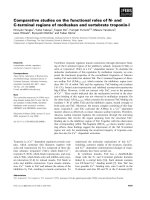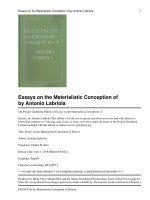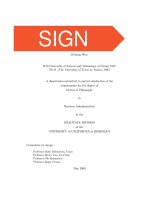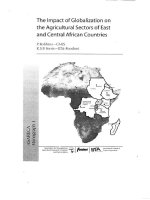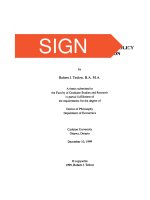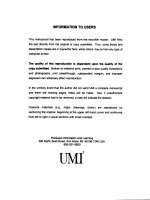Research " Essays on the Equilibrium Valuation of IPOs and Bonds " pdf
Bạn đang xem bản rút gọn của tài liệu. Xem và tải ngay bản đầy đủ của tài liệu tại đây (1.22 MB, 152 trang )
Essays on the Equilibrium Valuation of IPOs and Bonds
by
Kehong Wen
B.S.(University of Science and Technology of China) 1987
Ph.D. (The University of Texas at Austin) 1993
A dissertation submitted in partial satisfaction of the
requirements for the degree of
Doctor of Philosophy
in
Business Administration
in the
GRADUATE DIVISION
of the
UNIVERSITY of CALIFORNIA at BERKELEY
Committee in charge:
Professor Mark Rubinstein, Chair
Professor Henry Cao, Co-Chair
Professor Nils Hakansson
Professor Roger Craine
May 2000
UMI Number: 9981117
Copyright 2000 by
Wen, Kehong
All rights reserved
______________________________________________________________
UMI Microform 9981117
Copyright 2000 by Bell & Howell Information and Learning Company.
All rights reserved. This microform edition is protected against
unauthorized copying under Title 17, United States Code.
_______________________________________________________________
Bell & Howell Information and Learning Company
300 North Zeeb Road
P.O. Box 1346
Ann Arbor, MI 48106-1346
The dissertation of Kehong Wen is approved:
Chair Date
Date
Date
Date
University of California at Berkeley
May 2000
Essays on the Equilibrium Valuation of IPOs and Bonds
Copyright May 2000
by
Kehong Wen
1
Abstract
Essays on the Equilibrium Valuation of IPOs and Bonds
by
Kehong Wen
Doctor of Philosophy in Business Administration
University of California at Berkeley
Professor Mark Rubinstein, Chair
Chapter 1 of this dissertation provides rational explanations for the IPO underperformance
puzzle. IPO underperformance is shown to arise in three equilibrium models with investor
heterogeneity and participation restrictions. The models also help explain why IPO under-
performance is concentrated in small stocks and why the average IPO return can be below
the risk-free rate. In these models, IPO residual risk acts as a source of systematic risk.
Schumpeterian creative destruction plays a key role in one of the models. This model is
extended into a dynamic setting in Chapter 2 to demonstrate that persistent after-market
underperformance is consistent with a rational expectations equilibrium. Building on the
dynamic extension, a uni…ed framework is o¤ered in Chapter 3 to address all three IPO
pricing puzzles. Many testable implications are derived and presented in detail to facilitate
future empirical work.
Chapter 4 investigates the general equilibrium implications of introducing new
2
industries into the economy. It …rst establishes that the equilibrium of an N-industry pure-
exchange economy supports an N-factor Vasicek term structure of interest rates. It then
shows that industry characteristics enter as direct determinants of the yield curve, the
term premium, the forward premium, and the stock premium. Depending on the nature
of industry heterogeneity, the term structure of interest rates and the stock premium can
have qualitatively di¤erent dynamics. Depending on how industries interact, the market-
price-of-risk vector may admit di¤erent signs for its components. Consequently, risky assets
representing high impact industries can have negative return premia over bonds. This helps
explain why new industries may appear over-valued at times.
Professor Mark Rubinstein
Dissertation Committee Chair
iii
To my wife, Yunfang Lu,
and my daughter, Yanming Melinda Wen,
the stars in my life.
iv
Contents
List of Figures vi
List of Tables vii
1 A Rational Approach to IPO Underperformance 1
1.1 Introduction . . . . . . . . . . . . . . . . . . . . . . . . . . . . . . . . . . . . 1
1.2 Relation to Other Work . . . . . . . . . . . . . . . . . . . . . . . . . . . . . 8
1.3 Model Setup . . . . . . . . . . . . . . . . . . . . . . . . . . . . . . . . . . . 11
1.4 “Creative Destruction” . . . . . . . . . . . . . . . . . . . . . . . . . . . . . . 13
1.5 Heterogeneous Belief . . . . . . . . . . . . . . . . . . . . . . . . . . . . . . . 24
1.6 Preference for Skewness . . . . . . . . . . . . . . . . . . . . . . . . . . . . . 28
1.7 Long-run Underperformance: Benchmarks and Sources . . . . . . . . . . . . 33
2 A Dynamic After-market Model 36
2.1 Model Setup . . . . . . . . . . . . . . . . . . . . . . . . . . . . . . . . . . . 36
2.2 Equilibrium . . . . . . . . . . . . . . . . . . . . . . . . . . . . . . . . . . . . 39
2.3 Testable Implications . . . . . . . . . . . . . . . . . . . . . . . . . . . . . . . 44
2.4 Conclusion . . . . . . . . . . . . . . . . . . . . . . . . . . . . . . . . . . . . 46
3 A Uni…ed Approach to the Three IPO Puzzles 48
3.1 Introduction . . . . . . . . . . . . . . . . . . . . . . . . . . . . . . . . . . . . 48
3.2 Underpricing and Hot-issue Market . . . . . . . . . . . . . . . . . . . . . . . 52
3.3 Testable Implications . . . . . . . . . . . . . . . . . . . . . . . . . . . . . . . 60
3.4 Relation to Other Work . . . . . . . . . . . . . . . . . . . . . . . . . . . . . 62
3.4.1 Underpricing Literature . . . . . . . . . . . . . . . . . . . . . . . . . 62
3.4.2 Hot-issue Market . . . . . . . . . . . . . . . . . . . . . . . . . . . . . 66
3.4.3 Relation between Underperformance and Underpricing . . . . . . . . 68
3.5 Conclusion . . . . . . . . . . . . . . . . . . . . . . . . . . . . . . . . . . . . 69
4 Equilibrium Valuation in a Vasicek Economy with Heterogeneous Indus-
tries 70
4.1 Introduction . . . . . . . . . . . . . . . . . . . . . . . . . . . . . . . . . . . . 70
v
4.2 The Model . . . . . . . . . . . . . . . . . . . . . . . . . . . . . . . . . . . . 76
4.3 The One-factor Vasicek Model . . . . . . . . . . . . . . . . . . . . . . . . . 79
4.4 The Multi-factor Vasicek Term Structure . . . . . . . . . . . . . . . . . . . 85
4.4.1 The Two-factor Case . . . . . . . . . . . . . . . . . . . . . . . . . . . 85
4.4.2 Equilibrium Security Prices . . . . . . . . . . . . . . . . . . . . . . . 88
4.4.3 Properties of the Two-factor Term Structure . . . . . . . . . . . . . 90
4.4.4 The N-factor Case . . . . . . . . . . . . . . . . . . . . . . . . . . . . 96
4.5 Stock-fund Valuation . . . . . . . . . . . . . . . . . . . . . . . . . . . . . . . 97
4.6 Comparative Dynamics . . . . . . . . . . . . . . . . . . . . . . . . . . . . . 105
4.6.1 Yield Curve Dynamics . . . . . . . . . . . . . . . . . . . . . . . . . . 106
4.6.2 Term Premium and Stock Premium . . . . . . . . . . . . . . . . . . 107
4.7 Conclusion . . . . . . . . . . . . . . . . . . . . . . . . . . . . . . . . . . . . 110
5 References 112
A Proofs 118
vi
List of Figures
4.1 The solid line plots the quadratic function ± = 1 + "(1 +")´: The dotted line
plots the quadratic function " = ¡±(± ¡ 1)=´ ¡ 1: The Relative volatility is
de…ned as ´ = ¾
2
M
=¾
2
N
: . . . . . . . . . . . . . . . . . . . . . . . . . . . . . . 94
4.2 Extending Figure 4.1 into the full parameter space R
2
: . . . . . . . . . . . . 107
4.3 When relative volatility ´ is increased, the solid line narrows and drop down
further into the third quadrant. The dotted line ‡atten out. . . . . . . . . . 109
4.4 When ´ is decreased, the solid line ‡atten out, while the dotted line narrows
and expands further into the …rst quadrant. . . . . . . . . . . . . . . . . . 110
vii
List of Tables
1.1 Asset payo¤s with di¤erential positive skewness . . . . . . . . . . . . . . . . 30
4.1 Yield curve dynamics in the one-factor case . . . . . . . . . . . . . . . . . . 83
viii
Acknowledgements
I thank …rst of all my committee members for their general guidance for completing the
work presented in this dissertation. I thank Jonathan Berk, Henry Cao, Sanjiv Das, Pe-
ter DeMarzo, Greg Du¢e, Dwight Ja¤ee, Matthew Spiegel, Brett Trueman, Hal Varian,
Miguel Villas-Boas, Ivo Welch, and especially Mark Rubinstein, for helpful discussions and
comments. Jay Ritter provided very detailed comments on the work presented in Chapter
1. I also thank my fellow Ph.D. students at the Haas School of Business, especially Yuan
Ma, Mark Taranto, Zane Williams, Nick Wonder, and Hong Yan for helpful discussions.
1
Chapter 1
A Rational Approach to IPO
Underperformance
1.1 Introduction
For decades, researchers have been puzzled by three sets of empirical results as-
sociated with the pricing of initial public o¤erings (IPOs). Besides the well-documented
underpricing puzzle and hot-issue market puzzle
1
, severe long-run underperformance of
IPOs is reported recently by Ritter (1991) and Loughran and Ritter (1995), suggesting
that market ine¢ciency may be even more pervasive than previously recognized. Thus, the
IPO market, albeit small in scale, has become a leading example of anomalies against the
e¢cient market hypothesis (Fama 1998).
Current research in this area focuses on econometric issues and model speci…cation
1
See Ibbotson (1975) for the …rst systematic study on underpricing, and Ibbotson and Ja¤e (1975) for
their early work on hot-issue markets. Ibbotson and Ritter (1995) provide an extensive survey of the IPO
literature.
2
issues that are di¢cult to disentangle for long-window event studies (Brav and Gompers
1997, Barber and Lyon 1997, Brav 1998, Fama 1998, Loughran and Ritter 1998). Little the-
oretical work has been done, however, to o¤er insights into IPO long-run underperformance
and its relation to underpricing. Investor naivete appears to be a popular explanation for
these puzzling observations. For instance, Shiller (1991) proposes an “impresario” hypoth-
esis, which implies that investors are systematically fooled by investment bankers. Ritter
(1991) interprets some of his results as being consistent with Shiller’s hypothesis. More
recently, Teoh, Welch, and Wong (1998) argue that investors may be systematically fooled
also by earnings management of issuers. They conclude that “ it is unlikely that any
fully rational theory will be able to explain why some rational investors are willing to hold
IPOs in the after-market. Returns for what are likely to be risky and illiquid investments
are simply too low to be explained by known equilibrium models.”
The primary purpose of this chapter is to provide rational equilibrium models that
can explain low (average) after-market IPO returns
2
. Clearly, to develop such models, one
must go beyond the traditional Capital Asset Pricing Model (CAPM) of Sharpe (1964) and
Lintner (1965), since many assumptions underlying that model do not apply to the IPO
market. The approach taken here is to recognize and model two prominent features of the
IPO market that break the CAPM: participation restrictions and investor heterogeneity.
Two types of participation restriction are considered: share-supply restrictions and short-
sale restrictions. It is well known that almost all IPOs have lockup policies by which
insiders agree not to sell their shares until after a certain period of time (typically, 180
2
Chapter 3 studies the inter-relations among all three IPO puzzles, building on a dynamic model developed
in Chapter 2.
3
days or longer) has lapsed. It is also well known that shorting IPOs can be di¢cult, if not
entirely impossible. These restrictions in‡ate IPO after-market prices. Over time, however,
both restrictions are relaxed, since more shares become available when insiders sell more
of their shares or when IPO …rms issue more equities, and short sales become easier as
more shares become available for borrowing. The gradual relaxation of restrictions puts
downward pressures on price – leading to underperformance for IPOs, as compared to other
benchmark securities that have less or no such restrictions. These two e¤ects help explain
IPO underperformance, but they are not the only source of underperformance.
Investor heterogeneity contributes, in a more essential way, towards IPO underper-
formance. The fact that IPO investors are heterogeneous is evidenced by the unusually large
trading volume on the …rst public trading day of most IPOs (Miller and Reilly 1987, Hegde
and Miller 1989). The existence of large trading volumes in securities markets is one of the
important reasons for moving from the representative-agent model to explicit modeling of
investor heterogeneity (Varian 1989, Wang 1994). In developing a set of static models, I
allow, separately, for di¤erent endowments, di¤erent probability beliefs, and di¤erent pref-
erences. These models demonstrate that a certain degree of investor heterogeneity alone
can be su¢cient to generate IPO underperformance. Compounding on these heterogeneity
e¤ects are the e¤ects due to the short-sale cons
t with a rational equilibrium, some investors must have special reasons to
want to hold IPO stocks. These investors want the shares so much that they are willing to
pay high prices. Three such special reasons are considered explicitly. One, some investors
4
hold IPO stocks in order to hedge their human capital risks. Two, some investors have
more favorable probability beliefs for IPO stocks than other investors do. The short-sale
constraint prevents these other investors from driving down the after-market price. Three,
some investors exhibit preference for skewness, and IPO stocks are known to have positively
skewed distributions (see e.g. Ibbotson 1975, Barber and Lyon 1997).
Another key intuition is that investors in the IPO market are looking for something
special, something that they cannot get by holding seasoned securities. More precisely, some
investors are particularly interested in the residual risk (the risk which is not spanned by
existing securities) of IPOs. IPO residual risk acts as a source of systematic risk and is priced
in equilibrium. From the point of view that innovation is the source of sustained economic
growth and economic development (Schumpeter 1934, 1942), new enterprises represent the
future of the economic system. Therefore, the risk associated with the emergence of new
industries becomes part of the economy-wide systematic risks.
This paper shows how these intuitions work by constructing and solving three
completely speci…ed models. The set of static models are mostly extensions of Lintner
(1969)
3
along the aforementioned three dimensions of investor heterogeneity. Lintner (1969)
deals with the equilibrium impact of a no-short-sale constraint, in addition to a rich set of
other issues involving heterogeneous investors. I simplify his model setting to one with two
risky assets and two heterogeneous agents. Generalization to cases with more than two
risky assets and/or more than two agents is straightforward. I allow for di¤erent degrees
of short-sale constraints and derive explicitly the pricing impact by obtaining the shadow
3
I thank Mark Rubinstein for singling out to me this important reference.
5
price for the constraint.
In contrast to most recent IPO models, I retain the simplicity of symmetric infor-
mation in Lintner’s model. This allows me to deal with multiple risky assets fairly easily
and to extend one of the models to a multi-period setting in a straightforward manner.
This is not to deny the existence or importance of asymmetric information. However, for
the problem at hand, the results obtained here suggest that this popular assumption is not
necessary.
More importantly, I extend Lintner’s model to the case with heterogeneous endow-
ments, the case he does not consider in the paper. This case is particularly relevant in the
current study for two reasons. First, it is the most tractable case. The closed-form solution
is found to be strikingly simple and the price impacts of participation restrictions can be
clearly identi…ed with their sources. This greatly facilitates analysis and extension.
Second, an important idea related to Schumpeterian “creative destruction” (Schum-
peter 1942) is introduced in this case. Brie‡y speaking, one class of investors is endowed
with a non-tradeable asset that derives future payo¤ from existing knowledge. This estab-
lished knowledge is challenged by the introduction of new enterprises which frequently are
led by entrepreneurs equipped with innovative technologies. Initial public o¤erings of these
new enterprises provide a unique opportunity for the threatened investors to hedge against
the possible erosion of their future endowments. This hedging demand is a powerful motive
for these investors to hold IPOs in the after-market. As a result, this hedging-demand e¤ect
alone is su¢cient to explain the low expected return of IPOs.
Rational investors are willing to hold IPOs and receive low expected returns are
6
also obtained in the case that investors di¤er in their probability assessments and in the
case that some investors exhibit preference for skewness. These results help strengthen the
conclusion that rational models can produce the kind of IPO underperformance observed
from data. I also …nd that in these two cases, while share-supply restriction always has an
e¤ect, a short-sale restriction may or may not have an e¤ect.
I then develop in Chapter 2 a dynamic extension of the static model with heteroge-
neous endowments, so that the intertemporal aspect of IPO after-market performance under
the environment of changing participation restrictions can be analyzed. I obtain closed-form
solution for the dynamic rational-expectations equilibrium. The equilibrium concept used
is the Radner (1972) equilibrium of plans, prices, and price expectations. Using the model
solution, it is readily shown that, regardless of the number of periods, a similar underper-
formance result is obtained in the dynamic context as well. The most important message
regarding long-run performance that comes out of this exercise is two-fold. On one hand,
there are legitimate reasons to expect persistent IPO underperformance over the long run,
supporting the still controversial empirical …nding of Ritter (1991). On the other hand,
attributing such …nding to things such as persistent investor overoptimism is premature.
The dynamic extension also paves the way for linking long-run performance of IPOs to their
initial pricing mechanism
4
.
This paper also produces some unanticipated results, the …rst of which has to do
with the degree of underperformance. It is shown that under a mild condition, the expected
rate of return from IPOs can in fact be below risk-free rate. Such a surprising result has
4
This subject is taken up in Chapter 3.
7
previously been observed by Loughran and Ritter (1995) in their empirical work with data
spanning more than two decades, from the 1970s to the 1990s. At a …rst glance, this severe
underperformance presents an insurmountable hurdle to a rational theory. Indeed, it is
di¢cult to imagine such a result, which implies a negative risk premium, from an equilib-
rium model with homogeneous agents. The models presented in this chapter demonstrate
that, when a su¢cient degree of heterogeneity is allowed, this counter-intuitive result can
nevertheless be consistent with a rational equilibrium. In particular, the hedging demand
driven by the economic force of creative destruction is powerful enough to support such an
equilibrium.
The second of these unanticipated results is related to the well-debated size e¤ect
in the asset pricing literature (Banz 1981, Berk 1995). Within the IPO literature, Brav
and Gompers (1997) …nd that long-run underperformance of IPOs concentrates in small
issues, after controlling for size and book-to-market as two independent pricing factors.
Interpretation of this …nding is not clear, however, mainly because the Fama-French style
three-factor model used in that study is an empirically motivated model (see Fama and
French 1992). Absent a theoretical model in which size enters in a meaningful way, “one is
merely testing whether any patterns that exist are being captured by other known patterns”
(Loughran and Ritter 2000). This paper derives CAPM-like asset pricing relationships in
which size enters in a well-speci…ed way. In view of such relationships, the result found by
Brav and Gompers can be interpreted. As will be shown in Sections 1.4-1.6, the inverse of
the size of the IPO stock appears in the coe¢cients of factors that determine IPO expected
return. Hence, size matters in cross-sectional regressions, but not as a risk factor. And since
8
there is a negative sign in front of the coe¢cients, the smaller the size, the more severe the
underperformance, other things being equal.
The rest of the paper is organized as follows. Section 1.2 discusses the relation
between the explanation o¤ered here and those o¤ered in several published papers. Section
1.3 sets up the basic model structure for the three static models presented in Sections
1.4-1.6. A distinct type of investor heterogeneity is considered in each model. The most
important case is the one with heterogeneous endowments, in which the Schumpeterian
creative destruction process is formalized. This model is further developed into a multi-
period rational expectations model in Sections 2.1-2.2. Section 2.3 presents a number of
testable implications to facilitate future empirical work. Section 2.4 concludes and discusses
limitations and possible future extensions of the static and dynamic models developed in
Chapter 1 and Chapter 2. All formal proofs are collected in the Appendix.
1.2 Relation to Other Work
Miller (1977) provides an intuitive explanation for IPO underperformance based on
divergence of investor opinions, under the condition of no short sales. The partial equilib-
rium analysis is recently formalized by Morris (1996), who shows that heterogeneity of prior
beliefs and a binding short-sale constraint can support a …nitely lived price bubble. Morris
argues that this speculative bubble explains why IPOs appear over-valued immediately after
issuance, relative to their long-run values.
The explanation o¤ered by Miller or Morris relies on the hypothesis that divergence
of opinions would narrow over time after the IPO. The logic is that as the …rm grows older,
9
the value of assets in place will grow relative to di¢cult-to-value growth options. Whether
or not that does happen systematically is a di¢cult empirical issue. This paper does not
rely on heterogeneous beliefs as the sole source of IPO underperformance. Other forms of
investor heterogeneity are also important, and their implications are easier to test than the
implications derived from divergence of opinions.
Both Miller and Morris assume that short sales are not permitted for any stock.
However, substantial short interests exist for seasoned equities. IPOs, on the other hand,
are much more di¢cult to short at the beginning
5
. This paper allows di¤erent stocks to be
di¤erentially short-sale constrained. More importantly, the constraint on IPOs is allowed
to change over time.
Allowing di¤erential short-sale constraints also distinguishes my models from most
equilibrium models with multiple securities and short-sale constraints in the literature (see
e.g. Lintner 1969, Jarrow 1980, Sharpe 1992). Explicit pricing impact of the short-sale
constraint is derived in my models by obtaining its shadow price explicitly. This permits a
clear analysis on comparative statics.
A salient feature of the IPO market emphasized here is that IPOs face more pro-
nounced restrictions when they come to the market and that these restrictions are eventually
relaxed to some “normal” levels. Presumably, these market imperfections are all public in-
formation, and hence their e¤ects should be re‡ected in prices. Contrary to the position
taken in Miller (1977), my models show that explicitly incorporating market frictions tends
5
Wen (1999) contains references and discussions on related empirical facts. The key fact is that most of
the shares are closely held – the public ‡oat is typically only 10-30% of the shares outstanding immediately
after the o¤ering, and the pre-issue shareholders rarely allow thier shares to be borrowed for shorting. Also,
shares held in street name by the managing underwriter are most likely not available for shorting. I thank
Jay Ritter for pointing out this key fact.
10
to support the e¢cient market hypothesis (the semi-strong form), which merely says that
security prices re‡ect all public information. Section 4 shows, when the knowledge of market
frictions is included in the public information set, IPO prices follow a martingale process.
When the knowledge is omitted, IPO prices follow a strict supermartingale process.
Shiller (1990) presents an “impresario” hypothesis for IPOs. He argues that the
IPO market is subject to fads, and that investment bankers exploit these fads opportunis-
tically by underpricing IPOs to create excess demand, just as a manager of musical events
attempts to create an illusion of hot shows by issuing tickets at a sale price. Such temporary
fads must eventually fade away, resulting in long-run underperformance. This hypothesis
implies a signi…cant correlation between the measure of underpricing and the measure of
long-run underperformance. Empirical evidence does not appear to support this impli-
cation
6
. Another implication of Shiller’s hypothesis is that average cumulative abnormal
return, including the initial return, should not go below zero in the long-run. This is not
consistent with the results reported in Ritter (1991).
Similar to Shiller(1990), Ritter (1991) and Loughran and Ritter (1995) argue that
there is a “window of opportunity” in which investors are over-optimistic about new …rms’
prospects. Issuing …rms, instead of their bankers, take advantage of these swings of investor
sentiment by timing their IPOs. Firms that go public successfully within these windows
will then underperform relative to a market benchmark. While there is clear evidence of
timing in the IPO market (Lerner 1994), there is no clear reason why such a window opens
6
Ritter (1991) attempts to identify a relationship between underpricing and underperformance. He in-
cludes underpricing as a right-hand-side determinant in his OLS regression for long-run returns, and …nds
that underpricing is the only regressor having insigni…cant in‡uence. A similar result is found in Hanley’s
(1993) regression.
11
from time to time.
Teoh, Welch, and Wong (1998) …nd evidence suggesting that investors may be sys-
tematically fooled by issuing …rms’ earnings management. They …nd …rms that aggressively
manage their earnings when going public tend to underperform various benchmarks in the
after-market. It is reasonable to argue that if the earnings management e¤ect exists system-
atically, short sellers should be able to take advantage of it. The reason they cannot do so
could be because of the existence of short-sales constraints. If the short sale e¤ect is taken
into consideration, I conjecture that the earnings management e¤ect will be weakened.
In contrast to the above three explanations, which in one form or another rely on
investor naivete, the explanation o¤ered in this chapter is based on investor rationality.
1.3 Model Setup
This section develops three one-period models, focusing on the equilibrium pricing
impacts of the short-sale constraint and limited share supply when investors di¤er in their
endowments, beliefs, and preferences. The basic setup for these models is outlined as follows.
Asset and Distribution. Consider a competitive, pure exchange economy in which
there are only two risky assets: asset 1 stands for the “market” (excluding IPO stocks) and
asset 2 for an IPO stock (or a portfolio of IPO stocks). Let J ´ f1; 2g. There is also a
risk-free asset, with zero net supply, available for trading. Without loss of generality, let
the exogenous interest rate be zero. The payo¤ from asset 1 at the end of the period is
M, which is normally distributed with mean ¹
M
and variance ¾
2
M
. The payo¤ from asset
2 is aM + N, where a is a small fraction, and, in the case with heterogeneous endowments
12
N is normally distributed with mean ¹
N
and variance ¾
2
N
. In the case with heterogeneous
preferences, N has in addition a non-zero third moment (see Section 3.3). M and N are
independent. Hence, a measures the correlation between these two assets, and N represents
the component of the IPO payo¤ which is not spanned by existing securities, i.e. N is the
residual risk of the IPO
7
. In the case with heterogeneous beliefs, the probability assessment
is agent-speci…c (see Section 3.2). It is natural to assume ¹
M
À ¹
N
; ¾
M
À ¾
N
: I also
assume a
2
¾
2
M
¿ a¾
2
M
¿ ¾
2
N
to re‡ect the fact that the residual component N is a much
riskier component. All parameters are positive.
Investor Preference. For simplicity, I consider only two classes of investors, A and
B. Let I ´ fA; Bg. Each investor maximizes expected utility over end-of-period wealth:
E
i
[U
i
(W
i
)], i 2 I. The utility function for each agent is further specialized to the constant
absolute risk aversion (CARA) class in the …rst two cases. In the third case, preference for
skewness is introduced.
Endowment. Agents are endowed with initial …nancial wealth fW
i
0
g
i2I
. They are
also endowed with non-tradeable, uncertain incomes fe
i
g
i2I
that are received at the end of
the period.
Participation Restriction. There is no restriction on investment in asset 1. The
total number of shares of asset 1 is normalized to one. There is a lower bound l 6 0 for
shorting asset 2. It is de…ned as the negative of the ratio of the total number of shares
available for short sale over the total number of shares outstanding. IPO shares available
7
Mauer and Senbet (1992) provide an excellent discussion on why IPOs are best viewed as not being
spanned by existing securities, in a non-trivial sense. They also provide empirical evidence supporting this
view. They focus on the underpricing problem and do not develop a sequential, rational expectations model,
whereas in this paper I focus on long-run, sequential markets.

